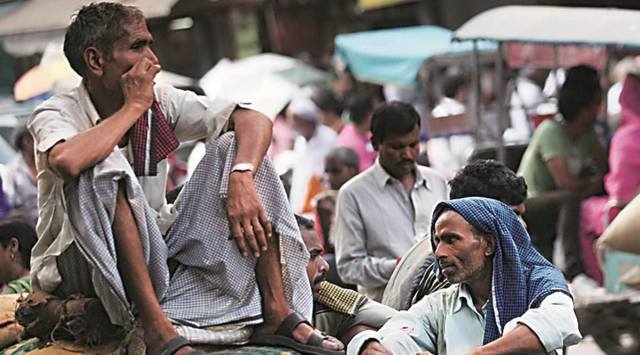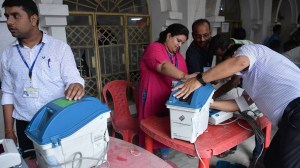- India
- International
Covid puzzles: Jobs back, labour shrinks, demand low but inflation still high
While much of the world is seeing benign inflation trends, India is a clear exception. Among the drivers of headline inflation in India in recent months has been food prices, especially those of vegetables.
 In the name of reforms, the rights of labour should not be compromised by clipping the wings of trade unions.
In the name of reforms, the rights of labour should not be compromised by clipping the wings of trade unions.With economic activity picking pace after the easing of lockdown measures, the recovery has thrown up some paradoxes: revival in employment amid a fall in labour force participation, surging inflation rate despite disinflationary impact from weak demand, and improvement in future outlook surveys even as the situation worsens in households.
In September, as lockdowns were progressively eased, an unusual labour market phenomenon was observed in India — while several workers got jobs, many who did not went on to leave the labour force, data collated by the Centre for Monitoring Indian Economy (CMIE) showed. Typically, when more people find jobs, as had happened during September, a greater number should have come in looking for jobs. The reverse seems to have happened, the CMIE estimates suggest.
Read | Have not closed the option for another stimulus: Nirmala Sitharaman
The unusual trend is explained by a rural-urban disaggregation of the data: rural India is seeing an increase in jobs while employment in urban India is on a slide.
For policy makers, there could be two significant takeaways: while labour data shows a recovery in employment, the quality of recovery is a problem – in other words, better quality and higher paying jobs in urban areas are being lost and substituted by lower-paid rural jobs. And this points to the fact that a reversal of migration back to the cities is not happening to the extent that it should have.

ExplainSpeaking | What IMF has said about the Indian and global economy
In September, according to CMIE, while overall employment increased by 5.1 million from 392.5 million to 397.6 million, unemployment declined by 7.3 million from 35.7 million to 28.4 million. The greater margin of the fall indicates that while many unemployed persons found jobs, others exited the market, leading to the labour force shrinking by 2.2 million from 428.3 million in August to 426 million in September.
Disaggregated data shows that in rural India, employment increased by 7.4 million and unemployment declined by a little over 5 million, pointing to a post-harvest-led increase in economic activity. At the same time, employment in urban India declined by 2.3 million and unemployment by 2.3 million. As a result, the labour force was reduced by 4.6 million in towns and cities in September — a monthly fall in the labour force of 3.3 per cent that is the highest since the meltdown month of April 2020.
This is qualified by surveys done by CMIE up to August, which have shown that the biggest losses in employment are in quality jobs — salaried employment. Salaried jobs typically offer better terms of employment and wages, and households with salaried jobs are better placed to build savings and plan a sustained improvement in standard of living. Such households are also better placed to borrow and service their borrowing because of the steady nature of their earnings. Going forward, this could have an impact on consumption trends and the recovery process in India.
There are other economic paradoxes that the pandemic has thrown up.
For instance, as against the general expectation globally that the massive demand shock from the pandemic would overshadow any supply shock and would therefore be disinflationary, the opposite has happened in India. While CPI inflation has consistently surged from just over 6 per cent in in June to nearly 7 per cent in each of the three months between July and September, some of it led by food inflation, the unexpected trend is the rise in core inflation — non-food, no fuel inflation — during a period when GDP growth is set to register a record contraction.
Also Read | How robust is India’s economic recovery post Covid-19 lockdown?
While much of the world is seeing benign inflation trends, India is a clear exception. Among the drivers of headline inflation in India in recent months has been food prices, especially those of vegetables. Also, the frequent rounds of hikes in excise duties on fuel, thrice in the last one year, coupled with increase in state levies of sales tax/VAT, are having a pass-through effect on the retail inflation.
But, the collapse in demand since March should have ideally triggered a drop in core inflation — price levels in non-food and non-fuel items. In the latest print for September, though core inflation softened marginally to 5.67 per cent from 5.77 per cent in August, it continued to stay above 5 per cent for the fifth consecutive month.
The most compelling explanation offered by economists is the disruption in supply chains post-March. Even after the national lockdown was lifted, the local lockdowns have impacted the supply chains that ensure goods are transported throughout the country. The severed links created shortages, adding to prices across the board. The repeated local lockdowns in states added to uncertainties for business and forced curtailments in their supply chains — impacting raw materials, intermediate goods, final products.
While real GDP in India is projected to contract in 2020-21 under the baseline scenario, reflecting both demand and supply shocks, consumer price inflation remaining elevated points to the fact that supply bottlenecks are outweighing the softening impact expected from weaker demand. These “counterintuitive inflation dynamics”, the Reserve Bank of India said in its latest MPC report, “have complicated the macroeconomic outlook”.
Another unexpected development is evident in the RBI’s latest consumer confidence survey. The central bank’s ‘current situation index’ fell to an all-time low in September, even as its ‘forward-looking surveys’ show that consumer confidence for the year ahead has improved. So even as the current situation of households has been progressively worsening, the survey points to households reporting better prospects for the future.
The dip in the ‘current situation survey’ in each of the months post June, with the estimates touching a new all-time low in each passing month, was reported despite the progressive opening up of the economy, offering a possible pointer to uncertainties in household perception of the economy and a dimming outlook on employment prospects.
More respondents in the RBI’s survey reported curtailment in overall and essential spending during the past one year, with the current situation index (CSI) dropping to 49.9 in September, from 53.8 in July and 63.7 in May. The survey was conducted among 5,364 households across 13 major cities, including Ahmedabad, Bengaluru, Bhopal, Chennai, Delhi, Guwahati and Hyderabad, via telephonic interviews.
Apr 18: Latest News
- 01
- 02
- 03
- 04
- 05







































